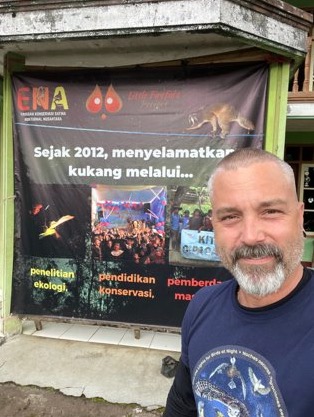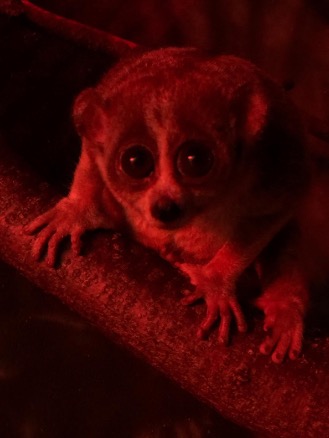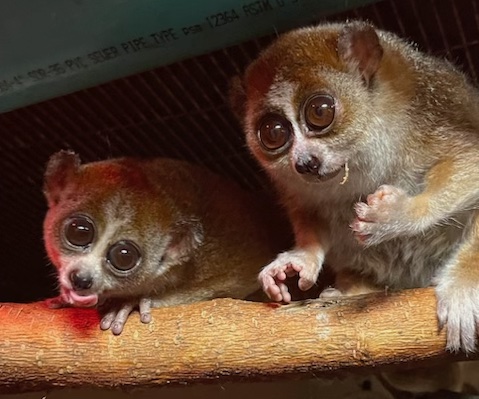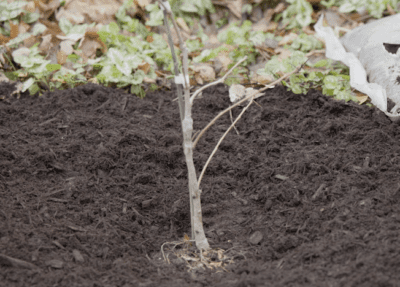More than a decade ago, slow lorises captured public attention when a social media post featuring one of these tiny primates raising her arms in response to being tickled went viral—a cute reaction that went unrecognized as a sign of distress by many viewers. Since then, many think pieces have been written on how devastating such videos were on the conservation of this species, increasing their presence in the illegal pet trade.
Lincoln Park Zoo is one institution working to regain ground regarding the conservation of slow lorises. Here’s what you should know about these intriguing nocturnal animals, their plight as an illegally trafficked species, and the zoo’s work with pygmy slow lorises in particular.
Legendary Lorises
Lorises are small, arboreal primates found in India, Sri Lanka, and parts of Southeast Asia. Lorises mostly eat tree gum, nectar from flowering trees, fruits, and insects. They have extra vertebrae that allow them to move with a serpentine motion. In their lower jaw, their teeth form a dental structure called a toothcomb. It’s very handy for scraping the resin off tree bark. They even have a second tongue for cleaning the bark and other food items out of their toothcomb.
They are venomous—in fact, they are the only venomous primate in the world. They have a special gland near their elbow that produces a toxic oil that must be mixed with their saliva to produce venom. Slow lorises use the venom as a defense mechanism when they compete against other lorises, but it can also protect them against predators. Loris venom is strong enough that humans have died from it.
There are actually 11 different species of loris, and all of them are considered either Threatened or Endangered by the International Union for the Conservation of Nature. At Lincoln Park Zoo, keepers work with one particular subspecies: the pygmy slow loris. This species is found in Vietnam, Laos, eastern Cambodia, and China.

And just for the record—they aren’t slow. They’re actually pretty fast, at least when they’re traveling through trees. The name comes from how they react when they see predators. “They’re called slow lorises because when you shine a light on them or they see a predator, they tend to freeze and they move very, very slowly. So for many, many years people thought they were that slow, but they’re very quick,” says Bryan Summerford, assistant lead keeper at Helen Brach Primate House and Regenstein Macaque Forest here at Lincoln Park Zoo.
These primates are known to some in their native range as “firefaces,” as that’s what the local Sundanese word for them (muka geni) means. And that’s why one organization devoted to studying their ecology, behavior and genetics, while also learning how to protect them in the wild, is called the Little Fireface Project (LFP).
The Little Fireface Project
Summerford has gone above and beyond when it comes to caring for slow lorises and participating in their conservation. Last year, he traveled to the village of Cipiganti in West Java, Indonesia through a designated keeper grant from the Faey family to help conserve these little mammals. That’s where the LFP initiated the first-ever long-term study of a loris species in the wild. In fact, the organization is into its 12th year studying the Javan slow loris.
The project was founded by Ana Nekaris, Ph.D., a professor at Oxford Brookes University, who is responsible for naming and elevating to species status (from subspecies) five of the 11 different types of loris. The Project has studied six of them for at least a year, providing a huge amount of data on their behavior and ecology.
Summerford, whose Indonesia experience is detailed in this magazine article, has seen firsthand how the LFP observes and records the social, vocal, posture, venom use, and reproductive behaviors of lorises, including five generations of the Javan slow loris. LFP also works with nearby Cikembulan Zoo to care for and release lorises where possible. Through Summerford, Lincoln Park Zoo donated enrichment items to this small zoo’s loris habitats as they were being improved.

Bryan Summerford in Indonesia
While he was there, Summerford helped make an existing loris habitat more structurally sound, safe, and interesting for the animals. Summerford also logged loris observation hours, participated in community outreach through visits to schools, and did a lot of learning. His knowledge base now includes information about life in Indonesia, conservation work with lorises, and how local communities are working with LFP to reconnect fragmented habitat for wildlife.
He managed to bring back a few items for the lorises here at Chicago’s free zoo, including a gouging block with crystallized gum to promote natural foraging behavior, a yucca/corn plant from their native range to promote natural nesting behavior, and an enrichment idea that mimics the waterline bridges used to connect fragmented habitat in Java to connect the lorises to unused portions of their habitat. He also recorded vocalizations of lorises which one day could be used for loris enrichment.
The main mission of the LFP is to use research to protect lorises in the wild and to stop wildlife trafficking, which is one of the biggest threats this primate is facing today. Their current status is precarious, and it has only gotten worse in recent years.
The Pet Problem
When the video of a slow loris being tickled went viral in 2009, it had a clear short-term result. Many social media viewers didn’t have slow lorises on their radar beforehand, but they did after. A 2013 study by Oxford University researchers found that illegal trade of these animals increased after 2010, when the Convention on International Trade in Endangered Species of Wild Fauna and Flora (CITES) listed them. Following this recognition of lorises as a species under threat, more were seen in domestic markets, online, and in rescue centers. In 2012, another video of a slow loris eating sticky rice went viral, fueling the trade even more.
The illegal wildlife trade is estimated to bring in about $20 billion a year and threatens many species of mammals, birds, fish, and reptiles. Lorises are often sent to large cities, where they are sold out of backpacks for as little as $20 U.S.
Unfortunately, animals often don’t fare well when they’re being illegally sent across borders—they’re often transported in crowded and unsanitary conditions, such as crates in the sweltering heat. This is especially true for slow lorises. They may have teeth cut or pulled in inhumane ways to prevent humans from their venomous bite. Procedures such as these—performed without anesthesia—can lead to infection and injury in their teeth and toothcombs. This prevents lorises from eating, grooming, and protecting themselves properly.

Some rescue organizations estimate that transporting lorises this way can have up to a 90 percent mortality rate. In 2013, West Java’s Cikananga Wildife Center received a group of 80 lorises, most from Sumatra, that were confiscated by the local forestry service. Of those, 90 percent needed medical attention immediately, and more than 30 died in the first month. The rest are unreleasable.
Lorises also require specialized care, so even those who make it unharmed to their destinations may experience poor nutrition and improper handling by well-meaning caretakers who don’t recognize or meet their needs properly. Inexperienced handlers may not understand signs of distress, like the ones shown on social media. Because they’re nocturnal, for example, they should not be kept awake during the day.
Pygmy Slow Lorises at Lincoln Park Zoo
Regenstein Small Mammal-Reptile House is home to three pygmy slow lorises: Meka, Ladybug, and Cosie. Cosie is the newest addition, a three-year-old who previously lived at Brookfield Zoo but arrived here about a year ago on a Pygmy Slow Loris Species Survival Plan® recommendation.
Meka: This 10-year-old male is a fan of insect rewards during his training sessions with keepers. Some of his training consists of voluntarily entering a crate for transport to the habitat where Cosie is housed behind the scenes.
LadyBug: She’s a 12-year-old female who can be seen hanging out with Meka in their habitat, which is lit with red bulbs that don’t disturb lorises’ natural cycles. LadyBug is fond of sleeping in paper pinatas made by zoo volunteers and she also loves insects.
Here’s a recent TikTok post that features one of the lorises chomping down on a crunchy snack:
Cosie: Cosie is a three-year-old who previously lived at Brookfield Zoo but arrived here about a year ago on a Pygmy Slow Loris Species Survival Plan® recommendation.
She has spent a lot of her last 12 months here working with staff training to voluntarily participate in her own medical exams—an important part of her care since she experiences kidney and urinary tract issues. The training might also turn out to be handy if she has any offspring in the future. Cosie, her training team, and the zoo’s vet staff have recently been successful in making sure she gets voluntary fluid injections.
Cosie loves gum arabic and romaine lettuce—and is one of the few animals at the zoo who reportedly does not like peanut butter as an enrichment item.
Take Action with Us
Lincoln Park Zoo has been a pioneer in research showing that seeing primates in human-style settings negatively impacts their conservation. As we work to save species, keeping slow lorises out of such images is one way anyone can help stem the tide of illegal trafficking and keep loris numbers sustainable in the wild.
So, when you travel, don’t pose for pictures with wildlife. Don’t like or share any videos showing lorises being exploited as pets—instead, flag them for animal cruelty. Support the conservation work being done to help these primates both in their native habitats and locally, at your favorite zoo.






